
Intro: RIDGE CROSSING
for mezzo-soprano
& piano
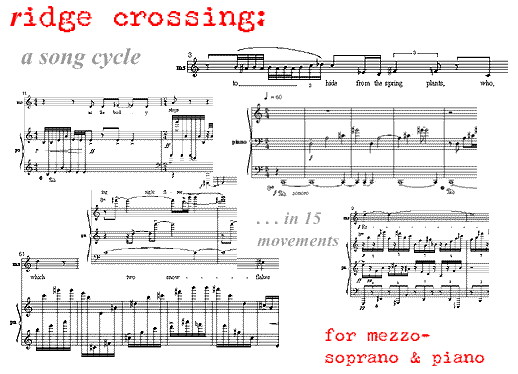
| download an MP3 of a performance model
RIDGE
CROSSING: MP3 [ 4.8 Mb]
[Windows = right click; Mac = option + click]
| download PDF of Ridge Crossing
[REQUIRES Acrobat Reader | [go to
text
]
[Windows = right click; Mac = option + click]
I:
Night-fire watch; II: The afternoon
river's roar; III: Waking in
wonder;
IV: Walking light;
V: The high sheltered space;
VI: The north-facing slopes;
VII: Through windflowers...;
VIII: A pathless passage;
IX: Moving on rhythm;
X: On the edge!:
XI: Sight!::
XII: Returning!:;
XIII: Coming down;
XIV: Traceless threads;
XV: A day rises
| back
to Circle/Square: Central
Display |
Music for Voice
| About Cliff Crego
|
Form as a pattern of movement .
. .
I like to think of the form of a poem as a pattern
which emerges out
of movement, much like the shape of a wave emerges out of the
formative flow of a stream. We hear the flow of spoken words, and
without trying to think about how the poem is written down or formally
structured, we sense a certain rhythmic pulse, a certain fluctuation of
density and texture. This is how I conceive of the poem's music,
again not so much as notation or what we see written on the page,
but rather as a kind of natural movement to be experienced.
With RIDGE CROSSING, I set out to explore the possibility of a new
kind of poetic miniature which is related to what in traditional rhetoric
is called syllabic verse. This is when we count the steps—or
syllables—
that a sequence of words makes in a phrase and arrange them in some
kind of outward, more or less pre-determined structure. The result is a
kind of dance which is made with language instead of our feet. After a
lot of trial and error and experimenting with this idea, I eventually came
up with a little 37-step form that was both short enough to be heard as
a single breath, yet at the same time long enough to create its own space,
perhaps even with a kind of storyline or center.
One of the beautiful things about a a relatively short form like this is
that it can be repeated, thereby creating a sequence of variations. I've
always been struck by the extraordinary richness of, for example, the
Shakespeare sonnets—all 140 steps each—when hearing, say, just
three
or four of them in slow, rhythmic succession. The flow from poem to
poem creates a wonderfully dynamic interplay of similarity and differ-
ence—similar in form, but different in actual content. This is, of
course,
no different than how we experience form generally in the natural world.
There, we encounter, for example, the same basic spiral structure in the
arrangement of seeds in a pine cone, or on the disk on a sunflower
or the threads of water in a whirlpool in a fast-flowing stream.
But instead of going back to traditional forms like sonnets or, for
example, haiku, with their 17 steps, I'd much prefer to work wih
something new. This is because I'm very much looking for an organic
fit between, on the one hand, the outward form, and, on the other, the
inner movement of meaning in a composition. And well, I would also
argue that new meaning in a way must have new form in order to
properly manifest.
One last thought for those readers interested in the relationship between
music and poetry: If one were to write the poems down as I say them
in musical notation, they would all have exactly 37 notes, but the
durations,
meters, accents, dynamics, and other articulations would look
—and sound—strikingly different. In contrast, when written down
in standard English script, the result is in a subtle and fascinating way
quite misleading. This is because they do indeed look almost identical,
just like a series of sonnets would, but, remarkably, the mode of notation
does not display any of the just mentioned important differences. In other
words, this is much like having to perform J. S.Bach from a simple
sequence of pitches with no indicated rhythm, which would be almost
impossible. So, in a way—just like music—the poems have to be
actually heard to be understood.
Ridge Crossing is then a longer sequence or cycle of 15 little 37-step
poems, (go to
text.)
The poems are collected together in five sets of three
and, as a whole, make a kind of ritual walk from valley floor over a
difficult,
dark, north-facing, mountain ridge and then continue on down the other
south-facing side of a new, unknown valley. (Instead of the title,
Ridge
Crossing, the sequence might just as easily have been called
North/
South. If the poems at first seem a bit austere in aspect, I suppose
that
has something to do with the granite-like ruggedness of the country out of
which they have emerged. I can only hope that they start to, as the saying
goes, 'sound right' after a time.
Meaning as musical texture;
the sequence of 15 movements . . .
(to go to scores, click on links or music
samples)
I:
Night-fire
watch
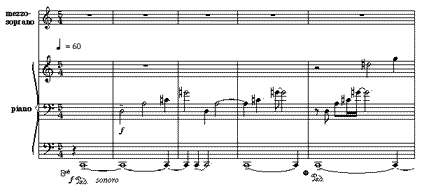
Night-fire watch
turns
to sleep, the soft glow of thoughts rolled
out on beds of feather and rock.
The arms of
whirling stars reach down,
a day rises on smoke and ash.
II:
The afternoon' river's roar . .
.

The
afternoon river's
roar now the gentle murmur of
dawn, a chorus of dreaming fish
sings of schools
of birch leaves soaring
straight out of the she-goat's milky eyes.
III:
Waking in
wonder

Waking
in wonder,
the darkness of the valley floor
stares breathless at the peak's rosy
blush, the face
of a mother play-
ing mad and a child feigning sleep.
IV:
Walking
light
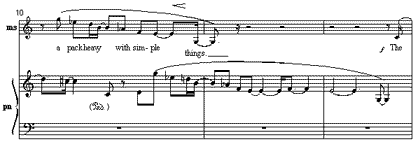
Walking
light, heading
south over a high mountain pass,
a pack heavy with simple things.
The rise and
fall of trees and snow,
a cycle spinning new each turn.
V:
The high sheltered
space
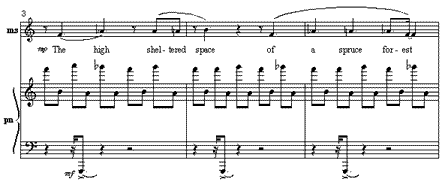
The
high sheltered space
of a spruce forest dissolves in-
to low knotty shrubs, tangled with
the light of
a thousand moons -- the
patience which lives i n s i d e thin air.
VI:
The north-facing
slopes
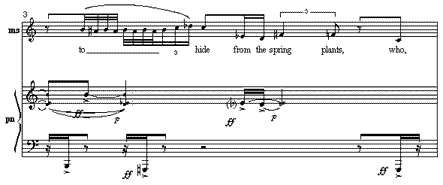
The
north-facing slopes
of the arduous life, where snow goes
to hide from the spring plants, who, after
long months of
snowy inwardness,
are ablaze with pinks and wild blues.
VII:
Through windflowers . .
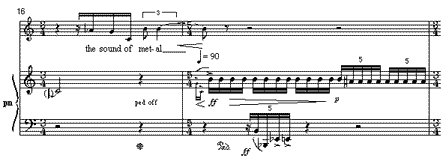
Through
windflowers filled
with a harp's gentle praise, stepping
out onto scree and misty snow.
Total white...
the s o u n d of metal-
on-ice the only moving
thing.
VIII: A pathless
passage
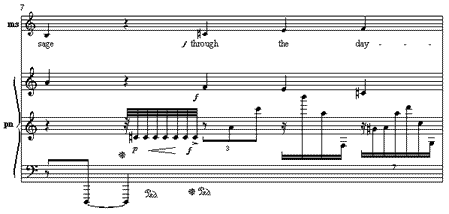
A
pathless passage
through the daytime boreal night,
through downhill winds which give no rest.
A darkness
so complete that ech-
oes crack and rocks fa l l forever.
IX: Moving
on rhythm
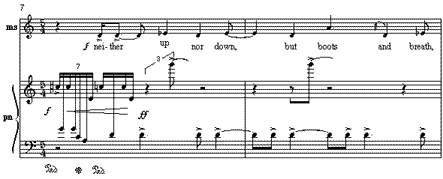
Moving
on rhythm,
not time, neither up nor down but
boots and breath, the idea of south
pressing down
bursts as the body
stops and the earth lets go at last.
X:
On the
edge!
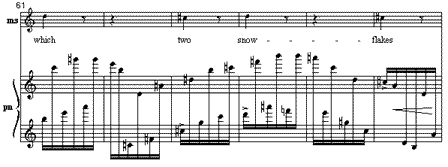
(featuring the *Swallow Klavier*)
On
the edge! The point
at which two snowflakes divide in-
to north and south, the children of
light and dark
parting ways, to meet
again on the far side of change.
XI:
Sight!

Sight!
So utterly
limited, incapable of
focusing on two eyes at once,
of looking
out on the whole of
north and south, grasping it as one.
XII:
Returning!
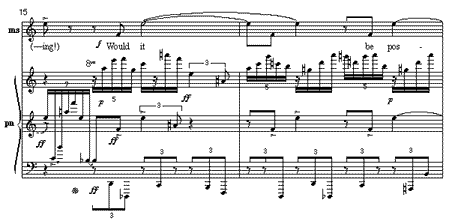
(featuring the *Ice Klavier*)
Returning!
Would it
be possible at all without
the distant green of the forest,
without the
steady rise and fall
of wind and rocks, of trees and
snow.
XIII:
Coming
down
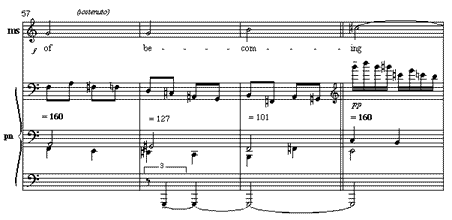
(featuring the *Water Klavier*)
Coming
down, a rain
drop runs the south edge of a ridge,
the grain of a slope offering
countless ways
of becoming a
stream, of flowing then returning.
XIV:
Traceless
threads
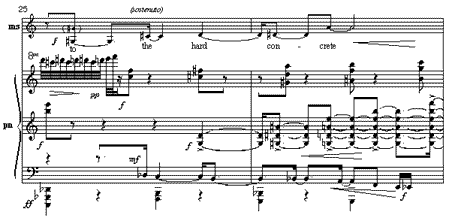
(featuring the *Granite Klavier*)
The
further down, the
more limited things become: a
self-spun traceless thread feels its way
to well-worn
paths, to jeep-trails, to
the hard concrete used every
day.
XV:
A day rises . .
.
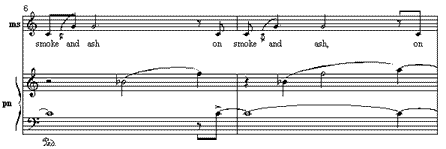
(featuring the *Star Klavier*)
A
day rises on
smoke and ash, eyes searching for whirl-
pool galaxies, sounds of water
and rock. Thoughts
turn, wither and dry,
feeding night-fires no one sees.
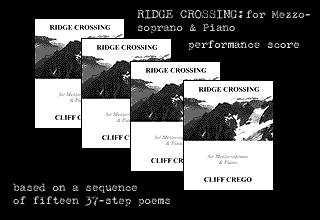
|
[DOWNLOAD:
Windows = right click; Mac = option +
click]
MP3
4.8
Mb
| pdf [57 A4 pages 840 K] |
| BUY Score ONLINE |
music and text
by Cliff Crego
|
| back to Circle/Square: Central
Display |
Music for Voice
| About Cliff
Crego |
Print one page at a time
from The Circle in the Square
© 2003 Cliff Crego
For more information, e-mail to
crego@picture-poems.com

















